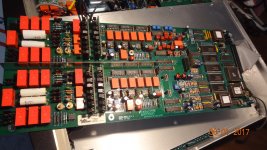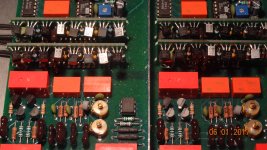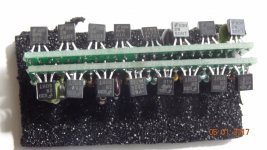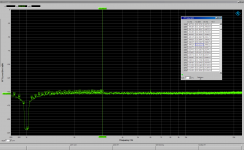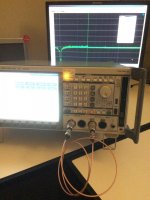I did not start the thread on a PCB for Victor's oscillator. Its starts here: http://www.diyaudio.com/forums/equi...-victors-low-thd-oscillators.html#post4164497 I need to open mine to see how i kludged it. Essentially i bypassed the two 100 Ohm resistors. The Lm317 + no resistors maximized battery life. important for 9V batteries which aren't cheap. I bought a pile from China via eBay. Years ago I visited the China factory making them (Only one then, probably still). They had every known brand on display since they made something like 80% of the world's 9V batteries. No good reason to buy premium batteries for this application.
I still get a significant improvement in noises using battery power. I have tried low noise linear and switching supplies but the power line to ground leakage is limiting performance.
Demian, have you tried a SilentSwitcher on a mains-free PowerBank? Did I send you one? Or would 30V total be insufficient?
Jan
Would you mind if I made a PCB for personal use using your design?I too liked the simplicity of this. Here's my pcb layout. I mounted + / - 15V regs on the pcb.
Brian.
Hi Richard,
Interestingly, they are still using the MPSA18 and 2N5087 as low noise parts. I still use those same parts, and even have some 2N5210's hiding around here.
-Chris
Interestingly, they are still using the MPSA18 and 2N5087 as low noise parts. I still use those same parts, and even have some 2N5210's hiding around here.
-Chris
Demian, have you tried a SilentSwitcher on a mains-free PowerBank? Did I send you one? Or would 30V total be insufficient?
Jan
I have it and will try it. My shop is in the low 50's F and no heat so I'm just not going there right now. I would really like a variant that has several 36V floating outputs, perhaps not even regulated, for applications like this.
I'm surprised or chna resource have not made something like it for that application. All I have found on eBay are non-isolated supplies. Ideal today might be a 5V in (to run off a generic USB charger) to floating 36V which can be locally regulated to run a typical load. There is one I found from Power One but its expensive and doesn't have that much power.
Essentially i bypassed the two 100 Ohm resistors.
That explains what I was missing before.
🙂
Patrick
Sorry, I should have made it clearer. I used one as the resistor for programming the LM317 which I tacked onto the resistor.
3- 12v batteries? cheap and long lasting....
A23 Alkaline 12 Volt Battery 5 Pack + FREE SHIPPING! - Brooklyn Battery Works
-RNM
A23 Alkaline 12 Volt Battery 5 Pack + FREE SHIPPING! - Brooklyn Battery Works
-RNM
Its listed as 55 mA/Hr and the Victor board with a CCS needs about 18 mA to operate Doing the arithmetic they will give you about 3 hours operation. Following these graphs http://www.alliedelec.com/m/d/bb267eb6105f9f310e61977288b88924.pdf you should be able to get about 15 hours. Even though the 9V is more money the 5X difference in life still makes it the first choice. Shame since clips for those 12V batteries look much easier to deal with. I hate the snaps.
Its listed as 55 mA/Hr and the Victor board with a CCS needs about 18 mA to operate.
Not so good in my opinion. The board was projected for to run from 25mA. The shunt stabilizers need little more current than 18mA for to have some reserve. As example - you wrote, that you can't start oscillator with a 600ohm load.
Personally, I use the gel cells... they are large and bulky and not cheap but last forever and rechargable... i just use my car trickle-charger on them... works fine every time.
When will Vic make a finish package osc? case, battery or supply etc. I still use the pcb circuit without a box for it and lash something together every time i want to use it.
meanwhile, i got the leaky ips protection fets replaced in one channel of the AP 2722 analyzer. Waiting for more parts on the other channel. Checking the internal gen now shows it is pretty decent to say the least.
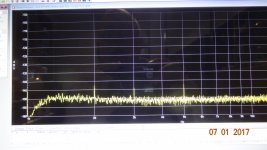
THx-RNMarsh
When will Vic make a finish package osc? case, battery or supply etc. I still use the pcb circuit without a box for it and lash something together every time i want to use it.
meanwhile, i got the leaky ips protection fets replaced in one channel of the AP 2722 analyzer. Waiting for more parts on the other channel. Checking the internal gen now shows it is pretty decent to say the least.

THx-RNMarsh
I have it and will try it. My shop is in the low 50's F and no heat so I'm just not going there right now.
Here that would be the point we would consider putting on long sleeve shirts 😀
I'm surprised or chna resource have not made something like it for that application. All I have found on eBay are non-isolated supplies. Ideal today might be a 5V in (to run off a generic USB charger) to floating 36V which can be locally regulated to run a typical load. There is one I found from Power One but its expensive and doesn't have that much power.
Most things that run off a USB charger (incl. the SilentSwitcher) also run fine from a 3.7V LiPo battery and then are fully floating. A single LiPo is much more friendly than a bank of large gel or other batteries.
A PowerBank is basically a LiPo with an internal boost converter anyway.
Jan
RNMarsh,
I don't know if it's my browser that doesn't work properly on DiyA, but when people add pictures directly inside the post instead of using the attachment function, and when clicking on the picture it takes me to another page and it's frustrating going through many pictures forth and back.
Would it be possible to add pictures instead as an attachment (Scroll down a bit below the comment text box and look for the "Additional Options" and the "Manage Attachment" button), it has some benefits:
1. The picture zoom in and out with one single mouse click without taking one to another web page.
2. The picture is possible to drag around when holding down left-mouse-button which is good when we want to zoom in large pictures, but also drag it a bit aside so one can view the post and correlate post with the picture.
3. It's possible to zoom in several pictures at once so one can verify them side by side, useful with measurements where details and differences are small.
EDIT: one more...
4. Using the Attachment functions allows also to upload a picture onto here from other web pages, in many cases people add only a link in the post and unfortunately I have already come across several dead links which some times render the post completely useless because one can't view the picture.
Thanks for the consensus.TOP
I don't know if it's my browser that doesn't work properly on DiyA, but when people add pictures directly inside the post instead of using the attachment function, and when clicking on the picture it takes me to another page and it's frustrating going through many pictures forth and back.
Would it be possible to add pictures instead as an attachment (Scroll down a bit below the comment text box and look for the "Additional Options" and the "Manage Attachment" button), it has some benefits:
1. The picture zoom in and out with one single mouse click without taking one to another web page.
2. The picture is possible to drag around when holding down left-mouse-button which is good when we want to zoom in large pictures, but also drag it a bit aside so one can view the post and correlate post with the picture.
3. It's possible to zoom in several pictures at once so one can verify them side by side, useful with measurements where details and differences are small.
EDIT: one more...
4. Using the Attachment functions allows also to upload a picture onto here from other web pages, in many cases people add only a link in the post and unfortunately I have already come across several dead links which some times render the post completely useless because one can't view the picture.
Thanks for the consensus.TOP
Last edited:
Personally, I use the gel cells... they are large and bulky and not cheap but last forever and rechargable... i just use my car trickle-charger on them... works fine every time.
When will Vic make a finish package osc? case, battery or supply etc. I still use the pcb circuit without a box for it and lash something together every time i want to use it.
meanwhile, i got the leaky ips protection fets replaced in one channel of the AP 2722 analyzer. Waiting for more parts on the other channel. Checking the internal gen now shows it is pretty decent to say the least.
View attachment 590430
THx-RNMarsh
That's better.
Nice work.
RNMarsh,
I don't know if it's my browser that doesn't work properly on DiyA, but when people add pictures directly inside the post instead of using the attachment function, and when clicking on the picture it takes me to another page and it's frustrating going through many pictures forth and back.
Would it be possible to add pictures instead as an attachment (Scroll down a bit below the comment text box and look for the "Additional Options" and the "Manage Attachment" button), it has some benefits:
1. The picture zoom in and out with one single mouse click without taking one to another web page.
2. The picture is possible to drag around when holding down left-mouse-button which is good when we want to zoom in large pictures, but also drag it a bit aside so one can view the post and correlate post with the picture.
3. It's possible to zoom in several pictures at once so one can verify them side by side, useful with measurements where details and differences are small.
EDIT: one more...
4. Using the Attachment functions allows also to upload a picture onto here from other web pages, in many cases people add only a link in the post and unfortunately I have already come across several dead links which some times render the post completely useless because one can't view the picture.
Thanks for the consensus.TOP
It is annoying but you might be able to adjust your browser so they don't open on another tab.
meanwhile, i got the leaky ips protection fets replaced in one channel of the AP 2722 analyzer. Waiting for more parts on the other channel. Checking the internal gen now shows it is pretty decent to say the least.
Congratulations - the sterling performance of your 2722 finally returns! Here's the FFT of a 1Vrms 1kHz after an "extreme" notch treatment on the UPV. The signal was routed from the generator to the analyzer externally through a RG316 cable to simulate connection to a DUT and reveal any possible EMF/RFI weaknesses in the chain, With H2 and H3 both around -151dB, it looks OK to me.
Attachments
Congratulations - the sterling performance of your 2722 finally returns! Here's the FFT of a 1Vrms 1kHz after an "extreme" notch treatment on the UPV. The signal was routed from the generator to the analyzer externally through a RG316 cable to simulate connection to a DUT and reveal any possible EMF/RFI weaknesses in the chain, With H2 and H3 both around -151dB, it looks OK to me.
You have nice toys.
What is victors user name on eBay? I'm trying to find one of his oscillators.
Sent from my iPhone using Tapatalk
Sent from my iPhone using Tapatalk
- Home
- Design & Build
- Equipment & Tools
- Low-distortion Audio-range Oscillator
